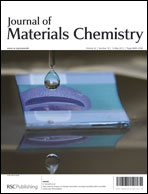Discriminative detection of bivalent Mn ions by a pH-adjustable recognition method viaquantum dot fluorescence sensing†
Abstract
In this report, we report a novel pH-controlled recognition method for the discriminative detection of Mn(II) and Cu(II) ions via CdTe QD fluorescence sensing. The detection limits of Mn(II) are 10 nmol L−1 to 5 μmol L−1. Our results indicate that the sensitivity of QD fluorescence sensing to Mn(II) strongly depends on the solution pH, whereas the sensitivity to Cu(II) is subject to a minor impact of pH. Therefore, the recognizable detection of Mn(II) and Cu(II) can be realized by adjusting the solution pH. The discriminative detection of Cu(II) is realized under Mn(II)-insensitive pH, whereas the recognition of Mn(II) is realized after the deduction of the Cu(II) impact by measuring the sample at both Mn(II)-sensitive pH and Mn(II)-insensitive pH. The mechanism for the peculiar pH-controlled sensitivity of Mn(II) is investigated, which is attributed to the pH-dependent diffusion and


 Please wait while we load your content...
Please wait while we load your content...